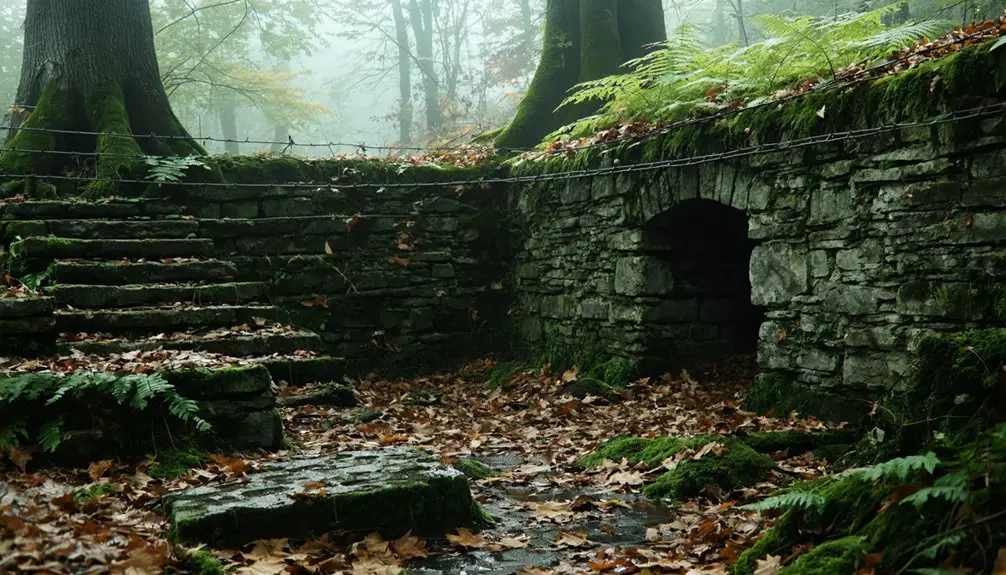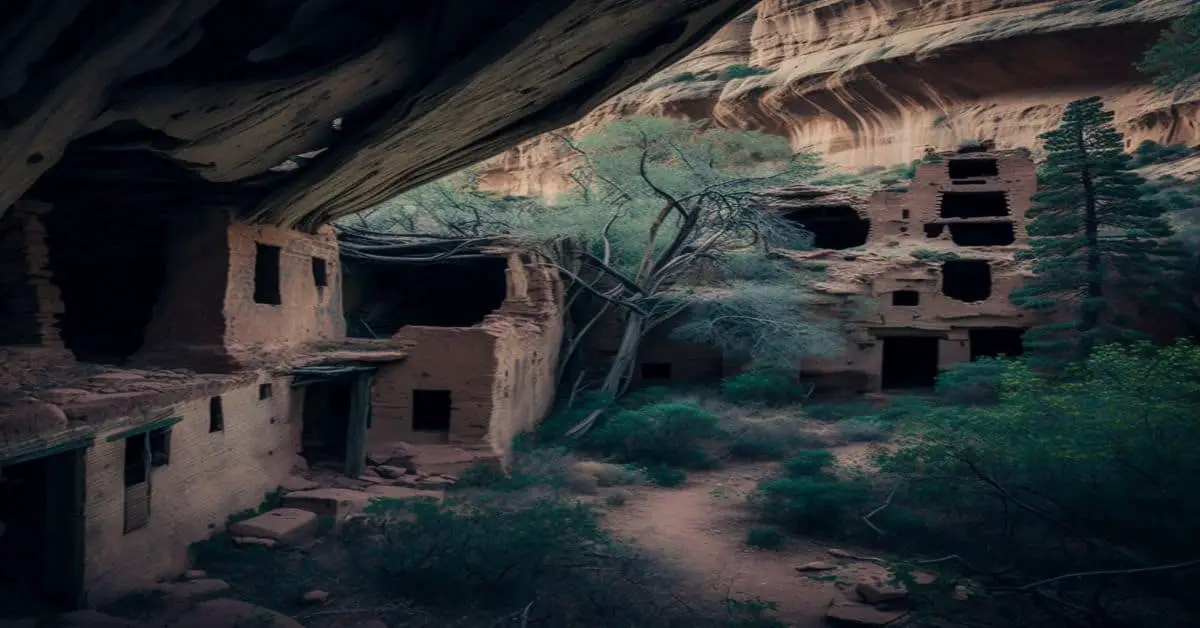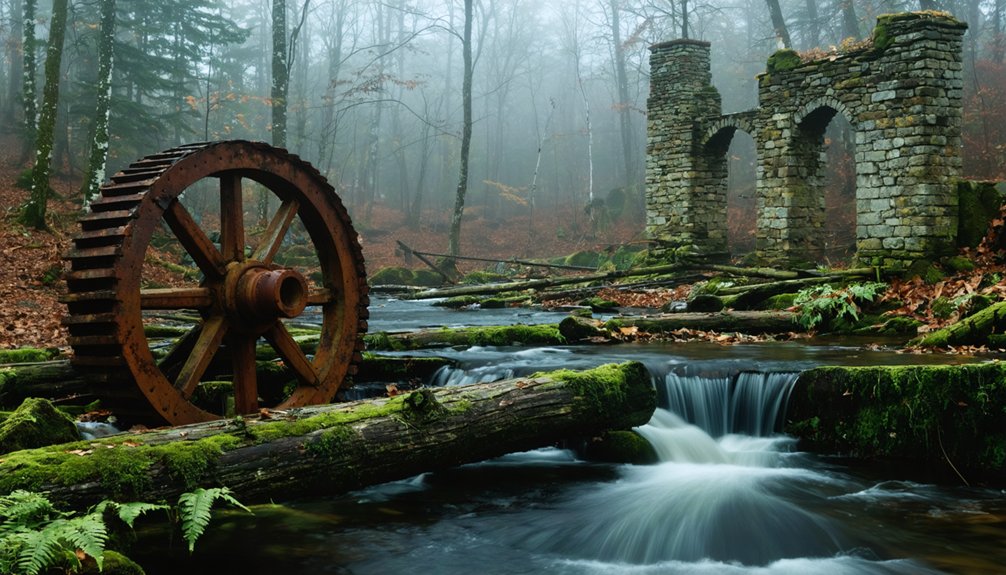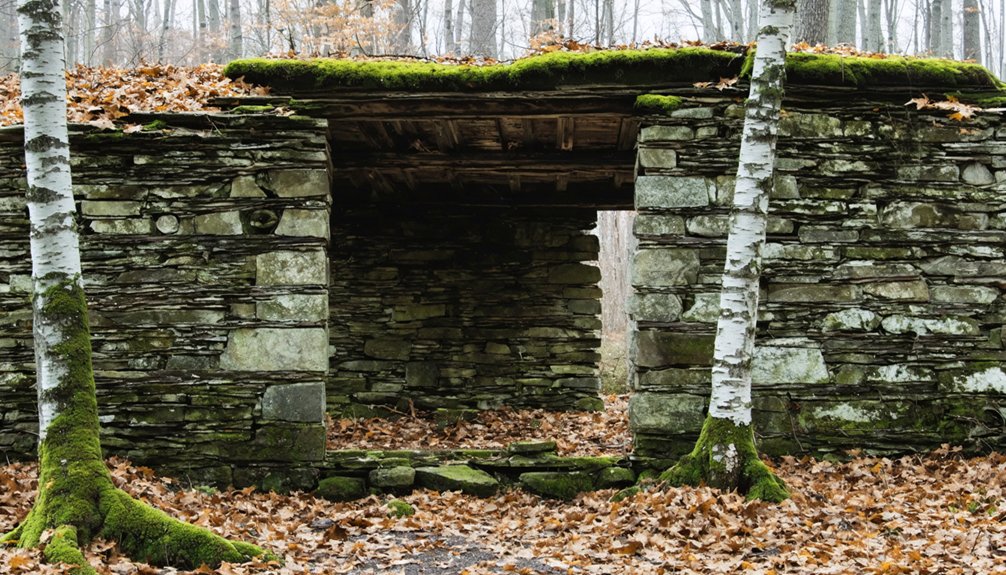You’ll find Zealand’s ruins deep in New Hampshire’s White Mountains, where J.E. Henry’s lumber empire once thrived from 1880 to 1897. This company town featured a post office, boarding house, store, and school, all connected by the innovative Zealand Valley Railroad. Henry’s aggressive logging earned him the nickname “Wood Butcher” as he clear-cut nearly a million acres. Today, stone foundations, railroad remnants, and cellar holes tell a complex tale of industrial ambition and environmental cost.
Key Takeaways
- Zealand was a bustling lumber town established in 1880 by J.E. Henry that became abandoned after timber resources were depleted by 1890.
- The town featured a complete infrastructure including a post office, boarding house, store, school, and railway system.
- Industrial ruins visible today include stone fireplaces, cellar holes, mill foundations, railroad tracks, and remains of the company hospital.
- Visitors can explore the ghost town via hiking trails, with informational plaques marking significant historical sites throughout the area.
- Zealand’s abandonment led to environmental reforms and contributed to the establishment of White Mountain National Forest in 1918.
The Rise of a Lumber Empire
While many New England lumber towns emerged during the late 19th century, Zealand, New Hampshire stood out as a particularly ambitious venture when J.E. Henry established it around 1880.
You’ll find that his logging innovations transformed the region, starting with a steam-powered sawmill equipped with multiple saws and a box-making machine.
By 1884, Henry’s vision expanded with the Zealand Valley Railroad, stretching 11 miles into virgin forests he’d acquired. The economic impacts were substantial as Henry built a complete company town with a post office, boarding house, store, and school.
Henry’s strategic Zealand Valley Railroad expansion drove local development, transforming pristine forest land into a bustling, self-sustaining logging community.
His operations evolved from water-powered to steam-operated mills, dramatically increasing timber processing capacity. The infrastructure grew to include two railroad stations connecting to major lines, positioning Zealand as a significant hub in the national lumber trade. His methods of clear-cutting timber caused widespread environmental damage. After achieving great success in Zealand, Henry strategically moved his loggers to Lincoln to expand his operations further.
James Everell Henry’s Vision
Although J.E. Henry’s ambitions focused primarily on profit, his vision would forever change the White Mountains landscape. You can trace his industrial mindset back to his farming roots in New Hampshire, where he developed a practical approach to resource utilization.
His grand plan involved extensive timber harvesting throughout the region, particularly in the remote Pemigewasset Wilderness. Born in 1831, he would become one of the most influential timber barons of his era.
Henry established the Zealand Valley Railroad and East Branch & Lincoln Railroad to access previously untouched forests. The logging consequences were severe – he earned the nickname “The Wood Butcher” as his operations devastated large forest tracts, especially in Zealand Valley by the 1880s. Henry was just twenty-three years old when Thoreau published his environmental masterpiece “Walden.”
Ironically, while his aggressive “cut it all” approach initially destroyed wilderness areas, his railroad grades later became the foundation for hiking trails, including sections of the Appalachian Trail that you can explore today.
Life in a Company Town
Under J.E. Henry’s iron grip, you’d find yourself living in a tightly controlled environment where your family’s entire existence depended on company approval.
If you were lucky enough to be deemed a “good man,” you’d join 80 to 250 other families in company-owned housing, shopping at the company store, and sending your children to makeshift schools in private homes.
You couldn’t escape company control even during meals, as worker regulations imposed fines for noisy behavior.
The Henry family held every position of power – from postmaster to tax collector – ensuring their authority touched every aspect of your life.
While you’d have stable employment at the steam sawmill or logging operations, you’d trade your independence for economic security, living under a system where one family owned everything from the boarding house to the railroad stations that connected you to the outside world.
The charcoal production in Zealand’s five kilns brought in more revenue than lumber sales, exceeding $75,000 in 1880.
By 1890, the once-thriving community faced its end when the timber resources were completely exhausted.
The Zealand Valley Railroad Era
When you visit Zealand today, you can walk the former rail corridor of the Zealand Valley Railroad, which J.E. Henry constructed between 1884 and 1885 to support his logging empire.
The 11 to 15-mile railway network, powered by 2-4-2 saddle-tank locomotives from 1886 onward, connected remote timber stands to Zealand’s 200-horsepower steam sawmill and two critical railway stations. Historical records show that timber barons dominated the logging operations throughout the White Mountains region during this era. Baldwin locomotives were particularly favored for their compact design features in navigating the challenging terrain.
You’ll find that this rail system formed the backbone of Zealand’s timber transport operations until 1897, linking the town to both the Boston, Concord and Montreal line and the Portland and Ogdensburg Railroad for broader market access.
Railroad Construction and Growth
During the late 1800s, the Zealand Valley Railroad transformed New Hampshire’s logging industry after its incorporation as the New Zealand River Railroad in July 1878.
You’ll find that railroad innovations quickly shaped the region’s community dynamics as J.E. Henry led construction efforts starting around 1884-1885. The skilled woods workers documented their daily experiences through firsthand accounts and photos of the railroad operations.
The railroad’s rapid growth brought dramatic changes to Carroll, New Hampshire:
- Workers laid 11 miles of track deep into dense forest territory
- Two strategic railroad stations connected to major lines: Boston, Concord & Montreal and Portland & Ogdensburg
- A powerful 200-horsepower steam sawmill processed the harvested timber
- Multiple spurs and staging areas facilitated efficient timber transport
Operations began in February 1886, enabling large-scale logging that would sustain the local economy until timber resources were depleted by the mid-1890s. The extensive logging operations led to significant habitat destruction and mudslides, prompting later forest management reforms.
Steam Power Transportation Network
As the Zealand Valley Railroad commenced operations in February 1886, J.E. Henry’s steam innovations transformed timber harvesting in northern New Hampshire.
You’ll find his railroad stretched 11-15 miles along the Zealand River, connecting remote forests to his 200-horsepower sawmill complex. The railroad’s specialized logging techniques relied on saddle-tank “Columbian” locomotives, designed to handle the rugged terrain while hauling heavy timber loads.
The rail network’s strategic connection to both the Boston, Concord and Montreal line and Portland and Ogdensburg Railroad meant you could efficiently move finished lumber products to distant markets.
Henry’s integrated system included multiple spur lines for log loading, while his Zealand mill complex featured rotary saws, shingle saws, and box-making equipment.
This steam-powered transportation network operated until 1897, fundamentally changing how New Hampshire’s forests were harvested.
Timber Transport Operations
The Zealand Valley Railroad’s timber transport operations revolutionized logging practices across northern New Hampshire from 1885 to 1897.
You’ll find the railroad’s narrow gauge tracks stretched 11 miles deep into remote forests, where saddle-tank steam engines worked tirelessly for log extraction.
The railroad’s efficient system transformed raw timber into valuable lumber at Zealand’s steam-powered sawmill before shipping it to broader markets through two essential railroad connections.
- Logs were pulled from dense mixed hardwood and spruce forests
- Timber moved directly to Zealand’s central sawmill for processing
- Multiple saw types handled diverse wood product creation
- Processed lumber shipped out via Boston, Concord and Montreal or Portland and Ogdensburg lines
Today, you can trace the old rail bed alongside Zealand River, where nature has reclaimed the once-bustling logging corridor.
Industrial Operations and Peak Production
You’ll find Zealand’s industrial heart in its 200-horsepower steam-powered sawmill, which processed timber hauled in by the Zealand Valley Railroad and connecting lines to Boston, Concord, Montreal, and Portland.
The mill’s workforce peaked at 250 employees who operated various saws and specialized equipment to produce lumber boards, shingles, laths, clapboards, and boxes.
The town’s strategic rail network allowed efficient transport of finished products while supporting the mill’s intensive clear-cutting operations across the White Mountain region.
Steam Mill Operations
Built in 1880 by J.E. Henry and partners, Zealand’s steam sawmill represented cutting-edge sawmill technology of its era.
You’d find this 200-horsepower industrial powerhouse equipped with advanced machinery for diverse lumber production, from dimensional boards to specialized wood products.
Walking through the mill, you’d witness:
- A massive rotary saw slicing through virgin timber with unprecedented speed
- Specialized saws crafting shingles, laths, and clapboards simultaneously
- An innovative box-making machine churning out commercial containers
- Large charcoal kilns feeding the steam engines for continuous operation
The mill’s steam power meant freedom from seasonal water limitations, enabling year-round production.
This industrial marvel transformed raw timber into finished goods, positioning Zealand as an essential hub in the White Mountains’ logging economy during the 1880s and 1890s.
Railroad Transport Network
Stretching across the rugged White Mountains, Zealand’s railroad network emerged in 1884 under J.E. Henry’s vision to revolutionize logging technology in New Hampshire.
You’ll find this narrow-gauge rail system extended 11-15 miles into virgin forests, connecting to major rail lines including the Boston, Concord and Montreal Railroad, and Portland and Ogdensburg Railroad.
During peak operations in the late 1880s through 1890s, this rail expansion transformed timber harvesting across Henry’s 10,000-acre domain.
The network’s strategic design included multiple stations, spurs, and sidings that enabled efficient log transport from remote cutting zones to Zealand’s 200-horsepower steam sawmill.
With direct links to regional hubs, you could move massive timber volumes beyond local markets, cementing Zealand’s position as a leading logging center until resources depleted in 1897.
Peak Employment Numbers
During its industrial peak in the 1880s, Zealand’s sawmill complex employed up to 250 seasonal workers who operated the facility’s diverse machinery, including rotary saws, shingle saws, and box-making equipment.
The workforce dynamics reflected the rugged independence of Northern New Hampshire’s logging industry, with seasonal fluctuations tied to timber availability and weather conditions.
You’ll find the scope of Zealand’s industrial might reflected in these key workforce elements:
- A 200-horsepower steam-powered operation requiring skilled machinery operators
- Specialized crews managing the extensive charcoal kiln operations
- Railroad workers maintaining crucial timber transport networks
- Skilled sawyers running multiple types of saws and box-making equipment
Workers lived in company-owned housing, creating a self-contained community that thrived until timber resources began declining in the early 1890s.
Daily Life and Social Structure
Life in Zealand revolved entirely around James E. Henry’s company control, where you’d find your housing, meals, and daily activities strictly regulated.
You couldn’t escape the watchful eye of management, as they owned everything from the stores where you’d shop to the hospital where you’d seek treatment.
Community dynamics centered on the company-provided facilities, with workers gathering at the communal dining halls under strict behavioral rules. You’d face fines for wasting food or making too much noise during meals.
Workers endured rigid control even during meals, gathering in company dining halls where noise and waste brought monetary penalties.
Worker regulations touched every aspect of daily life, from scheduled mill shifts to railroad timetables. While basic amenities like schooling for children existed in private homes, you’d find no independent social clubs or local government to support personal freedoms.
The company store served as the primary hub for both necessities and social interaction.
Natural Resources and Environmental Impact
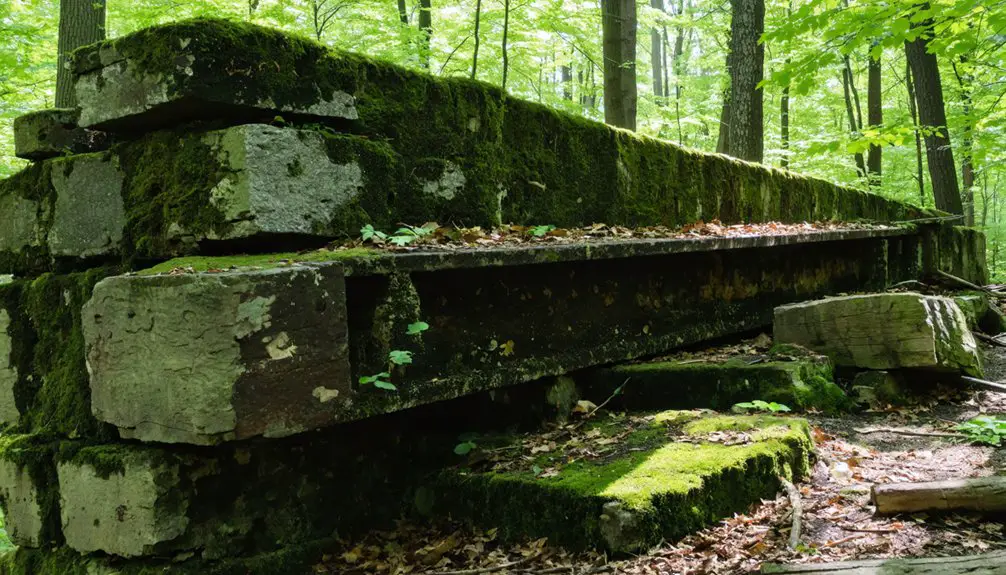
While Zealand’s initial prosperity stemmed from its rich timber resources within the White Mountain National Forest, the town’s aggressive logging practices would ultimately seal its fate.
J.E. Henry and Van Dyke’s companies clear-cut nearly a million acres of virgin forest, leading to devastating deforestation effects across the White Mountains region.
You can still see the environmental impact through:
- Severe soil erosion scars along former logging sites
- Remnants of burned landscapes from frequent forest fires
- Mill ruins and charcoal kilns dotting the Ammonoosuc River
- Abandoned railroad beds and granite underpasses
These destructive practices prompted significant environmental conservation efforts, leading to the creation of White Mountain National Forest in 1918.
While nature has slowly reclaimed the area, Zealand’s industrial remnants serve as stark reminders of humanity’s capacity to exploit natural resources.
The Final Years and Abandonment
As Zealand’s vast virgin forests vanished in the late 1880s, the town’s fate became increasingly clear. The J.E. Henry & Sons lumber company, which controlled every aspect of life in Zealand, began shifting operations elsewhere by 1892 as timber supplies dwindled.
Without economic resilience beyond logging, the town couldn’t adapt to changing circumstances.
A devastating fire in the late 1890s destroyed the remaining lumber stock and mill infrastructure, dealing the final blow to any hopes of community adaptation.
The Zealand Valley Railroad‘s reduced activity cut off crucial transportation links, while the company’s withdrawal eliminated essential services.
By 1897, the post office closed, and Zealand’s remaining residents departed.
Today, you’ll find only scattered remnants of the former mill near Zealand Campground, marking where this company town once thrived.
Ghost Town Remnants Today
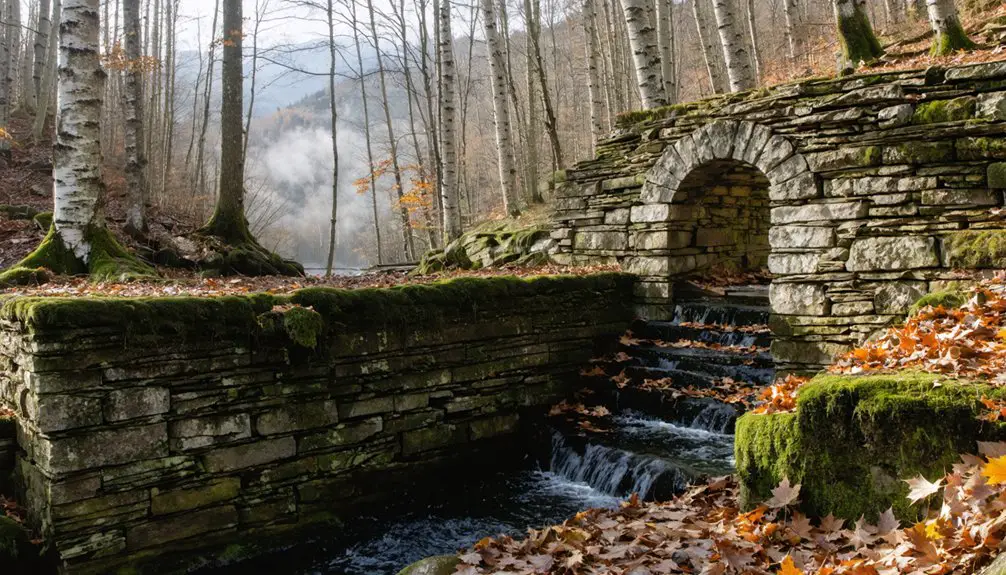
Beneath the dense canopy of White Mountain National Forest, Zealand’s ghost town remnants tell the story of its industrial past through scattered foundations, rusted machinery, and weathered stone markers.
Scattered among White Mountain’s towering trees, Zealand’s industrial ruins whisper tales of a forgotten New Hampshire logging town.
Historical preservation efforts focus on protecting these ghostly exploration sites while allowing nature to reclaim what’s left of the logging community.
When you venture into Zealand today, you’ll discover:
- Stone fireplaces and cellar holes marking former homes
- Railroad track segments from the Zealand Valley Railroad
- Mill foundations with visible water channels
- Company hospital ruins reflecting the town’s industrial heritage
You’ll need to navigate carefully on foot trails, as the forest has embraced these ruins.
While informational plaques guide visitors near major sites, the remote location and untamed vegetation create an authentic abandoned town experience within the protected wilderness.
Frequently Asked Questions
What Happened to the Residents After Zealand Was Abandoned?
You’ll find ghost stories of Zealand’s residents scattering desperately across New Hampshire, with many joining nearby logging towns like Lincoln or Fabyan, while others followed J.E. Henry’s ventures for new work opportunities.
Were There Any Documented Deaths or Accidents in Zealand’s Sawmill?
You won’t find any documented fatalities or specific sawmill accidents in Zealand’s records, though the dangerous nature of logging operations in 1880s New Hampshire suggests incidents likely occurred but went unreported.
How Did Families Celebrate Holidays and Special Occasions in Zealand?
You’d have found holiday traditions centered around the company boarding house, with family gatherings, communal meals, and seasonal celebrations shaped by logging schedules and strict company rules for socializing.
Did Any Original Buildings or Structures Survive Until Modern Times?
You’ll find no complete original buildings standing today, but you can explore architectural remnants including mill foundations, cellar holes, charcoal kilns, and a granite railroad underpass under historic preservation protection.
What Native American Tribes Previously Inhabited the Zealand Area?
You’d be amazed – the Abenaki weren’t alone in calling Zealand home! The Pennacook tribe and smaller Pequawket bands also roamed these lands, hunting and fishing across New Hampshire’s rugged northern wilderness.
References
- https://newenglandhistoricalsociety.com/six-new-england-ghost-towns/
- https://nutfieldgenealogy.blogspot.com/2010/10/where-heck-is-zealand-new-hampshire.html
- https://www.whitemountainhistory.org/abandoned-towns/zealand
- https://newenglandwithlove.com/ghost-towns-in-new-hampshire/
- https://en.wikipedia.org/wiki/List_of_ghost_towns_in_New_Hampshire
- https://www.lincolnnh.gov/about-lincoln/pages/history
- https://newenglandhistoricalsociety.com/new-hampshire-timber-baron-takes-money-runs/
- https://www.nhptv.org/kn/itv/ournh/ournhtg13.htm
- https://www.nhmagazine.com/a-glimpse-at-nhs-logging-history/
- https://www.scenicnh.com/blog/2013/04/pemi-wilderness-history-james-e-henry/
